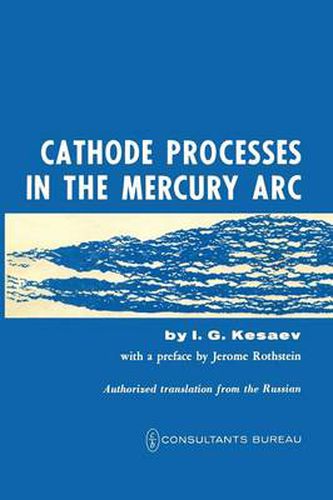Readings Newsletter
Become a Readings Member to make your shopping experience even easier.
Sign in or sign up for free!
You’re not far away from qualifying for FREE standard shipping within Australia
You’ve qualified for FREE standard shipping within Australia
The cart is loading…






This title is printed to order. This book may have been self-published. If so, we cannot guarantee the quality of the content. In the main most books will have gone through the editing process however some may not. We therefore suggest that you be aware of this before ordering this book. If in doubt check either the author or publisher’s details as we are unable to accept any returns unless they are faulty. Please contact us if you have any questions.
Although the electric arc is perhaps the oldest field in elec tronics, it is still one of the least well understood. The beautiful and complex phenomena accompanying the conduction of electricity in gases have led to the development of spectroscopy (and thus of atomic structure and quantum theory), discovery of isotopes, of the electron itself, of X-rays and thus to Moseley’s discovery of atomic number, to the discovery of electron emission, and thus to modern electronic technology as well as to much of modern physics. The properties of the plasma state of matter, which until relatively recently could be produced only by the passage of electricity through a gas, have helped explain many natural phenomena ranging from lightning, the aurora, and the ionosphere to solar, stellar, and mushroom-cloud physics. Many plasma devices, such as neon signs, sodium and mercury lamps, thyratrons, ignitrons, and mer cury pool rectifiers, have been with us for decades, and more are still being invented. To name but a few recent ones, we have plasma torches, plasma propulsion devices for space flight, and magnetohydrodynamic generators. Solving the problem of contain ing a high -energy plasma would lead to controlled energy generation by nuclear fusion. Plasma physics is thus more vigorous than ever in spite of its venerable old age. Kesaev’s book is concerned in its entirety with one of the least satisfactorily understood aspects of the relation of a plasma to the electrodes bounding and maintaining it.
$9.00 standard shipping within Australia
FREE standard shipping within Australia for orders over $100.00
Express & International shipping calculated at checkout
This title is printed to order. This book may have been self-published. If so, we cannot guarantee the quality of the content. In the main most books will have gone through the editing process however some may not. We therefore suggest that you be aware of this before ordering this book. If in doubt check either the author or publisher’s details as we are unable to accept any returns unless they are faulty. Please contact us if you have any questions.
Although the electric arc is perhaps the oldest field in elec tronics, it is still one of the least well understood. The beautiful and complex phenomena accompanying the conduction of electricity in gases have led to the development of spectroscopy (and thus of atomic structure and quantum theory), discovery of isotopes, of the electron itself, of X-rays and thus to Moseley’s discovery of atomic number, to the discovery of electron emission, and thus to modern electronic technology as well as to much of modern physics. The properties of the plasma state of matter, which until relatively recently could be produced only by the passage of electricity through a gas, have helped explain many natural phenomena ranging from lightning, the aurora, and the ionosphere to solar, stellar, and mushroom-cloud physics. Many plasma devices, such as neon signs, sodium and mercury lamps, thyratrons, ignitrons, and mer cury pool rectifiers, have been with us for decades, and more are still being invented. To name but a few recent ones, we have plasma torches, plasma propulsion devices for space flight, and magnetohydrodynamic generators. Solving the problem of contain ing a high -energy plasma would lead to controlled energy generation by nuclear fusion. Plasma physics is thus more vigorous than ever in spite of its venerable old age. Kesaev’s book is concerned in its entirety with one of the least satisfactorily understood aspects of the relation of a plasma to the electrodes bounding and maintaining it.